
Coreopsis is a genus of flowering plants in the family Asteraceae. Common names include calliopsis and tickseed, a name shared with various other plants.

Ilex verticillata, the winterberry, is a species of holly native to eastern North America in the United States and southeast Canada, from Newfoundland west to Ontario and Minnesota, and south to Alabama.

Mollugo verticillata, the green carpetweed, is a rapidly spreading annual plant from tropical America. In eastern North America, it is a common weed growing in disturbed areas. It forms a prostrate circular mat that can quickly climb over nearby plants and obstacles. The species has been reported from every state in the United States except Alaska, Hawaii, and Utah, as well as from British Columbia, Manitoba. Ontario, Quebec, New Brunswick and Nova Scotia. Although considered an invasive weed, M.verticillata is also known to be edible. Archaeological evidence has shown that M. verticillata has been in North America for about 3000 years. Sometimes also referred to as "Indian chickweed", in China this plant is referred to as zhong leng su mi cao.

Schiedea verticillata, known as the Devils Slide schiedea or Nihoa carnation, is an endangered species of plant in the family Caryophyllaceae, endemic to the island of Nihoa in the Northwestern Hawaiian Islands, where it was discovered in 1923 by the Tanager Expedition. It has been listed as endangered since 1996.
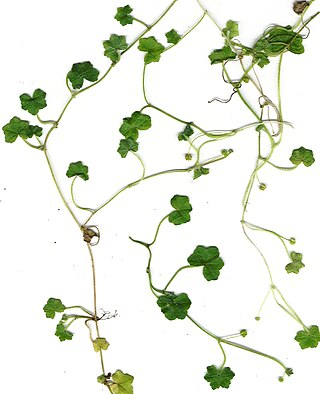
Hydrocotyle, also called floating pennywort, water pennywort, Indian pennywort, dollar weed, marsh penny, thick-leaved pennywort and even white rot is a genus of prostrate, perennial aquatic or semi-aquatic plants formerly classified in the family Apiaceae, now in the family Araliaceae.

Hydrocotyle ranunculoides, known commonly as floating pennywort, or floating marshpennywort, is an aquatic plant in the family Apiaceae. It is native to North and South America.

Asclepias verticillata, the whorled milkweed, eastern whorled milkweed, or horsetail milkweed, is a species of milkweed native to most of eastern North America and parts of western Canada and the United States.

Coreopsis verticillata is a North American species of tickseed in the sunflower family. It is found primarily in the east-central United States, from Maryland south to Georgia, with isolated populations as far west as Oklahoma and as far north as Québec and Ontario. The common names are whorled tickseed, whorled coreopsis, thread-leaved tickseed, thread leaf coreopsis, and pot-of-gold.

Hydrocotyle verticillata, also known as whorled pennywort, whorled marshpennywort or shield pennywort, is a flowering plant found in South and North America and the West Indies. Its creeping habit and unusual leaves give it its common names. It grows in places that are marshy, boggy, or even wet.
Hydrocotyle verticillata is used in aquaria, where it is undemanding; it does prefer a good substrate, however, and at least moderate light. It benefits from additional carbon dioxide. It is widely used as a foreground plant.

Hydrocotyle vulgaris, the marsh pennywort, common pennywort, water naval, money plant, lucky plant or copper coin, is a small creeping aquatic perennial plant native to North Africa, Europe, the Caucasus and parts of the Levant.
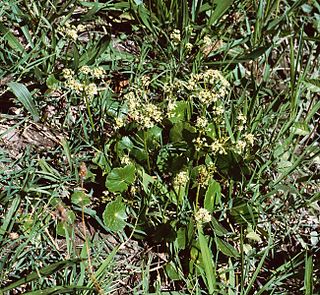
Hydrocotyle bonariensis, the largeleaf pennywort, once a member of the family Apiaceae, now in the family Araliaceae and of the genus Hydrocotyle, is a hairless and creeping perennial.

Ribes aureum, known by the common names golden currant, clove currant, pruterberry and buffalo currant, is a species of flowering plant in the genus Ribes native to North America.

Malus baccata is an Asian species of apple known by the common names Siberian crab apple, Siberian crab, Manchurian crab apple and Chinese crab apple. It is native to many parts of Asia, but is also grown elsewhere as an ornamental tree and for rootstock. It is used for bonsai. It bears plentiful, fragrant, white flowers and edible red to yellow fruit of about 1 cm diameter.

Cylindropuntia prolifera, known by the common name Coastal cholla, is a species of cactus. In Australia it is called 'Jumping Cholla' because of it seeming to jump from outbreak to outbreak.
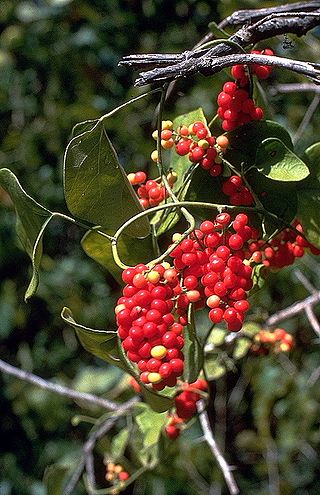
Cocculus carolinus, commonly called the Carolina coralbead, or snailseed, or Margil's Vine, is a perennial vine of the moonseed family (Cocculus). It is native to North America, where it is found in Mexico and in several states in the United States from the Southeast to the Midwest.

Malva verticillata, also known as the Chinese mallow or cluster mallow, is a species of the mallow genus Malva in the family of Malvaceae found in East Asia from Pakistan to China. M. verticillata is an annual or biennial that grow up to 1.7 meters in high and can inhabit woodland areas of different soil types. The small, symmetrical flowers have five white, pink or red petals (0.8 cm) and 13 or more stamens. Each flower has 3 narrow epicalyx bracts. The fruit is a dry, hairless nutlet. The leaves are simple and alternate.

Rubus argutus is a North American species of prickly bramble in the rose family. It is a perennial plant native to the eastern and south-central United States. Common names are sawtooth blackberry or tall blackberry after its high growth.

Isotria verticillata, commonly known as the large whorled pogonia and purple fiveleaf orchid, is an orchid species native to eastern North America.
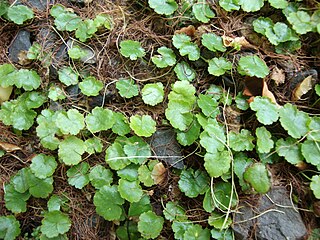
Hydrocotyle sibthorpioides is a small plant native to southeastern Asia. It is also referred to as lawn marshpennywort. It is a dicot, traditionally placed in the family Apiaceae, but more recently suggested to belong in the Araliaceae. It grows in abundance when the conditions are right. Hydrocotyle sibthorpioides originated in southeastern Asia, but is slowly spreading in the United States, along with other places around the world. It can grow in a wide variety of habitats. It has been used for medicinal purposes in Asia and is also common in the aquarium trade.
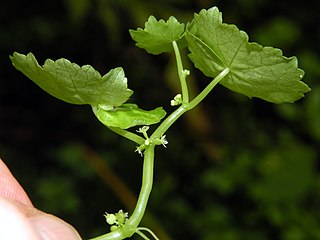
Hydrocotyle americana is a small plant native to the Northeastern United States. It is commonly referred to as American marshpennywort or navelwort and American water-pennywort. H. americana grows from Ontario to Newfoundland south through the Appalachian mountains to South Carolina. H. americana has been introduced to South Africa as well as New Zealand.




















